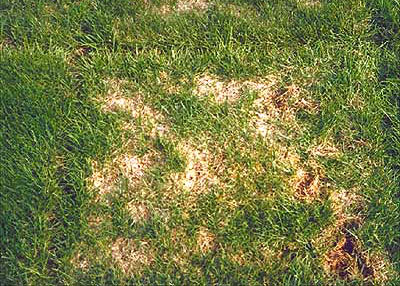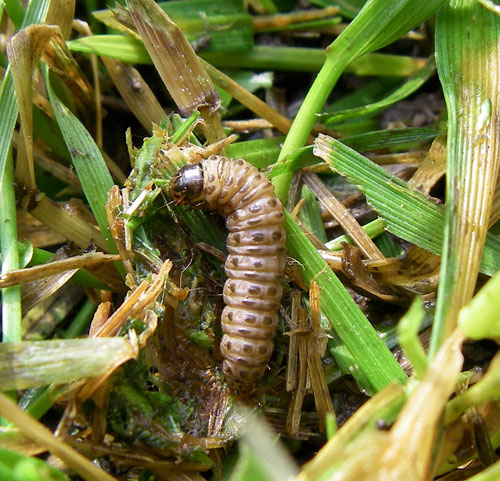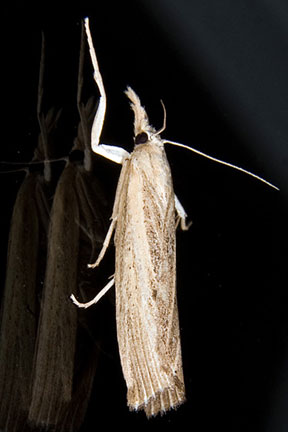Insect pests now appearing in turf
A lot of webworm moths are being observed now, but it may be chinch bugs that are damaging home lawns. Japanese beetles are out as well, and they are hungry.
There are several insects that are being reported around Michigan right now. Sod webworm moths have been seen flying in Kentucky bluegrass roughs and green surrounds, as well as in home lawns. At this time, the best strategy is to watch and wait. Turf damage from the larvae (webworms) will likely not occur for several weeks if it occurs at all. Often, a healthy, beneficial insect population will prey on the larvae and make pesticide applications unnecessary. Correctly diagnosing pests prior to pesticide applications is a key aspect of integrated pest management (IPM) and correctly identifying sod webworm damage is no exception.

Sod webworm damage. Photo credit: K. Mathias, UMD
You can bring webworm larvae to the surface by pouring a three gallon bucket of water with 1 oz of dish wash soap over the infested area. Wait three or four minutes for the ivory-colored caterpillars to appear. Also, look for green, chunky frass (droppings) that look like tiny bales of freshly cut hay.


Left, sod webworm larva.Photo credit: Purdue University. Right, sod webworm moth. Photo credit: bugguide.net
In home lawns, sod webworm is often blamed for damage caused by chinch bugs. This happens because people see the webworm moths flying over damaged turf, but they miss the tiny chinch bugs hiding in the thatch. We are now seeing the first turf injury from chinch bugs. Chinch bug activity will continue through July and early August. To confirm chinch bugs, you need to get down on your hands and knees and look for the tiny chinch bugs (1/8 inches long) near the turf or soil interface around the base of grass stems.
We've also had reports of ataenius grubs appearing on golf courses. When wilting or patches of dead turf appear in places where there are also more than five grubs per cup-cutter sample, spray with Dylox or Sevin at the grub rate. If your soil pH is 7.8 or higher, repeat the application in three days because both Dylox and Sevin degrade rapidly in high pH soils.
With the dry conditions across much of the state, it is likely to be a great year for European chafer grub damage. Now is the ideal time to treat turfgrass areas with preventative insecticides to ensure grub damage is not a problem in September and October. Make sure to irrigate with at least 0.5 inches of water following application to ensure the insecticide is thoroughly watered into the soil. See www.turf.msu.edu and click on “Home Lawn Grub Control” to find the best products to use for grubs.
With the warm spring and early summer, we are already seeing a lot of Japanese beetles. This is about two weeks ahead of an “average year.” Japanese beetle activity is expected to increase through the next three weeks, peaking by mid- to late July this year in southern half of Michigan. Watch for feeding damage to lindens, purple leaf plums, birch, roses and many other plants.
Finally, ant mounding on tees and greens has already reached a peak and ant activity is expected to slowly taper through July and August to levels about 1/2 to 1/3 of what you are seeing now. The best treatments for reducing ant mounding are Meridian, Aloft and Arena at the high rate in early June. However, if you did not use one of these products earlier, you can still make an application now to areas where you are having a problem. Treating 10 to 20 feet into surrounding turf will slow the rate at which the ant re-colonizes tees, greens and the edges of fairways.
Drs. Smitley and Frank's work is funded in part by MSU's AgBioResearch.



 Print
Print Email
Email




